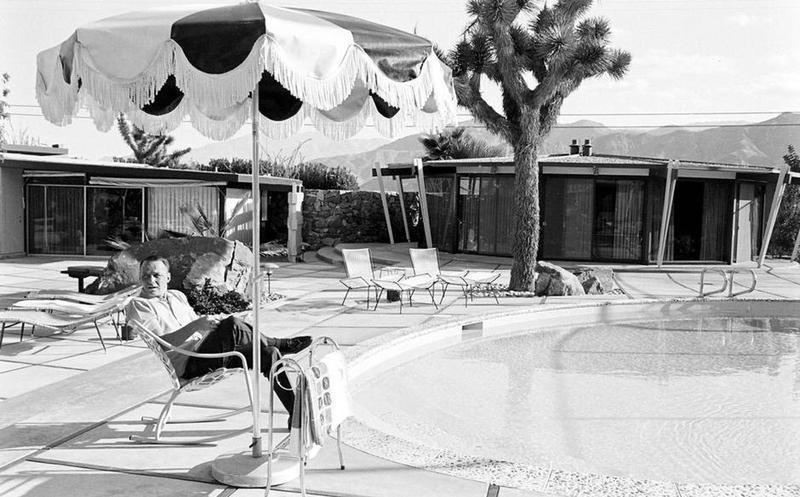Ten Things You Never Knew About Frank Sinatra's Palm Springs Home, "Twin Palms"
By | September 8, 2022

Frank Sinatra was early to Palm Springs. He beat the jet setters and modern art collectors, he even arrived before many of his fellow celebrities. He showed up in the 1940s and turn the sleepy desert hamlet into a place where stars felt comfortable letting their hair down.
Ol' Blue Eyes initially arrived in Palm Springs on the hunt for a weekend getaway for his young family in the 1940s following his first major contract with MGM. He worked with architect E. Stewart Williams to craft a home that's not only become a piece of Sinatra history, but a Palm Springs landmark.
Sinatra initially wanted a mansion

As a young gun with money burning a hole in his pocket Sinatra really wanted his new neighbors to know that he was a big shot. Hence his request for Williams to design a Georgian-style mansion (lots of columns, very austere). In 1940, not only would this kind of palatial estate scream NEW MONEY at the top of its lungs but it wouldn't match our vision of Sinatra and the modern '50s and '60s that he imbues.
A $150,000 starting price

Williams was able to direct Sinatra away from the mansion of his dreams with a design for something much more sleek made with non-traditional building materials. Not only did the architect want to create something a little more "desert appropriate" but he knew that his firm would be financially ruined if they built a mansion in the middle of the sand and heat. Sinatra got on board and paid more than a $150,000 commission for the construction of the home. No problem, right?

After paying the 150 grand Sinatra was anything but a hands-off buyer. He wanted Williams to finish the house by mid-December for a big Christmas party that he was throwing, which left only a few months for the architect to take the designs from dream to reality.
Construction on the house was ongoing affair, kicking up the price of the house to an undisclosed rate that we're sure is completely normal and not at all insane, but the home was finished on time and that's all Sinatra cared about.
A place like no other

When the home was finished (in time for the big Christmas party) it was more than just a cool house. It became the norm for postwar Hollywood casual living. Dubbed "Twin Palms," the modern and non-traditional home saved as the backdrop for some of the most sensational and unhinged moments of Sinatra's life.
Twin Palms has everything

Measuring in at more than 4,500 square feet, Twin Palms has everything that a swinging bachelor could want. There are four bedrooms and seven bathrooms for optimal hosting, and the house is laid out in long, horizontal lines that give it that exquisite modern feel that never goes out of style.
There's a grand piano-shaped pool (allegedly designed that way on accident), and instead of just having a plain old primary bedroom there's an entire wing dedicated to the owner of the house. When Sinatra was living on the site he added recording studio so he could work without having to make the hour and a half trip to Los Angeles.
From a family home to a love nest

Things were good for Sinatra and his young family in the early days of Twin Palms. He, his wife, and his three children loved spending time out in the desert when the singer and actor was taking a break from being one of the most famous people on the planet, but Sinatra's infidelities soon ended this brief, happy moment.
In 1948, Sinatra and his wife Nancy divorced and Twin Palms became a decadent oasis in the desert where the whiskey never stopped flowing and stars of stage and screen came and went as they pleased. Most notably, Ava Gardner became Sinatra's live-in chippy for a while after the divorce.
King of the Movie Colony

As a major part of the "Movie Colony" section of Palm Springs, Twin Palms was the hub of activity for stars of the Golden Ea of Hollywood. When Sinatra was in town it was like the president had returned from a long stay in a foreign country. Supposedly the singer would raise a flag bearing the Jack Daniels logo letting everyone in the Colony know that it was time to stop by and have a cocktail. The famous wet bar that Sinatra used can still be seen inside Twin Palms, just don't touch any of the good stuff or you'll be thrown out faster than Lana Turner.
Drama in the high desert

Sinatra was a drama magnet, and once Ava Gardner was living on the premises with the singer full time Twin Palms became a place where stars could indulge in their most illicit fantasies way from the prying eyes of the paparazzi. It was also home to a legendary fight where Sinatra allegedly threw a bottle of champagne at Gardner which just missed her and instead cracked the sink in the primary bathroom. The crack is still in the sink to this day.
Sinatra's art remains inside

Aside from the sleek modern style of the home, Sinatra was practitioner of hard-edged, Rothko influenced paintings that were popularized in the '50s and '60s. These geometrically pleasing paintings feature a variety of colors juxtaposed against one another in multiple abstract layouts.
Sinatra wasn't just a fan of abstract-expressionism. The singer also liked to get his feels out by painting clowns, specifically sad clowns. Following his break up with Gardner, Sinatra is alleged to have painted a morose clown that looks strangely like Ol' Blue Eyes while inside Twin Palms.
Goodnight Twin Palms

Following his divorce from Gardner in 1957, Sinatra left the home for good and moved on to a similar home in Chatsworth and a pair of Penthouses in New York, New York.
